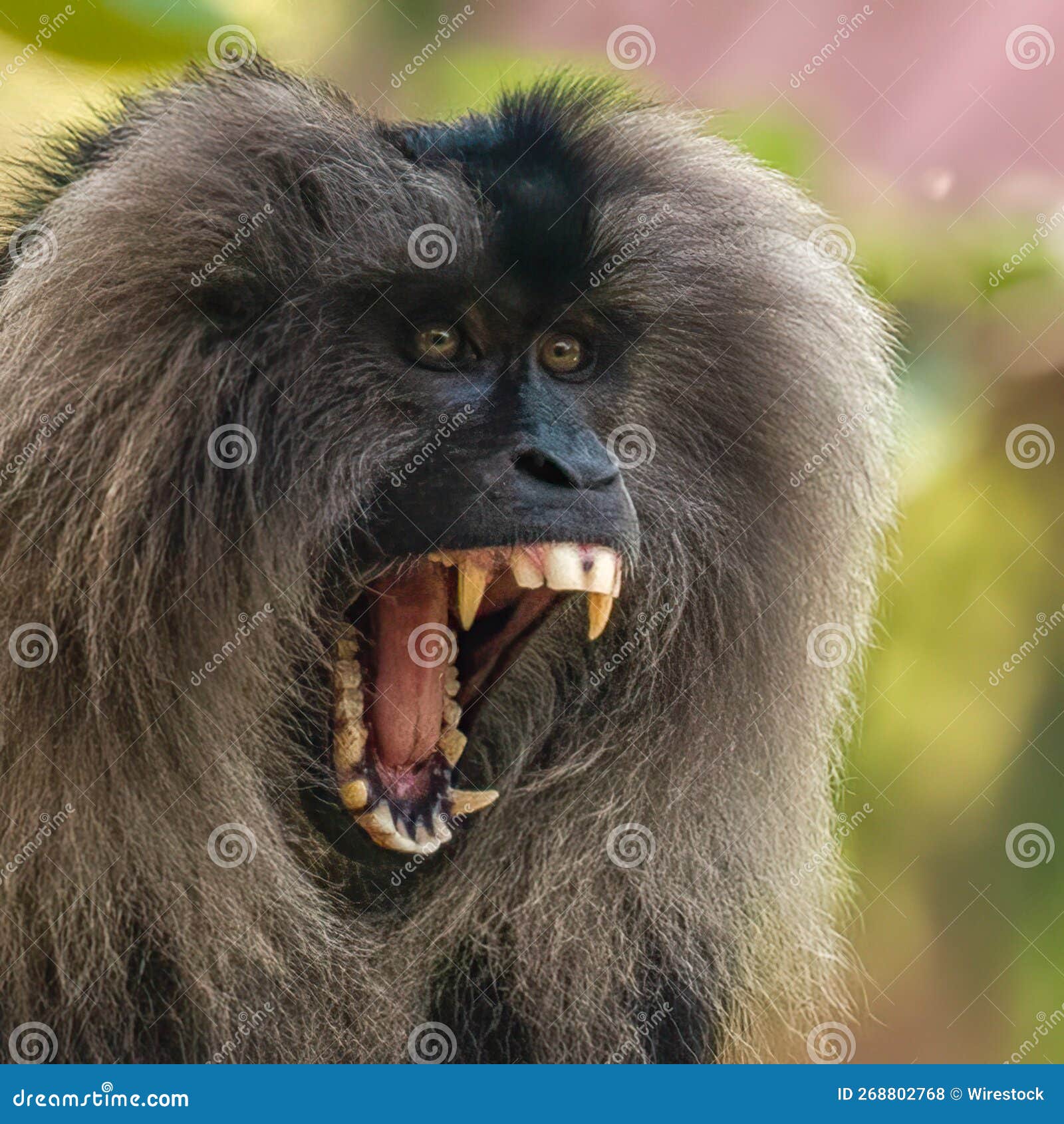Lion Screaming At Monkey: The Roar That Shook The Jungle!
Ever wondered what happens when a lion decides to let out a roar straight at a monkey? Well, buckle up because we’re diving deep into this wild phenomenon that’s got nature enthusiasts talking! Lion screaming at monkey is not just a random occurrence; it’s a fascinating display of animal behavior that reveals so much about the dynamics of the jungle. Let’s explore why lions roar, how monkeys react, and what this means for the delicate balance of the ecosystem.
Picture this: a lion standing tall on a rock, its majestic mane billowing in the wind, and then—BOOM! A deafening roar that sends shivers down the spine of every creature within earshot. But what happens when that roar is directed at a monkey? Is it a warning, a show of dominance, or something else entirely? Stick around as we unravel the mystery behind this thrilling encounter.
This isn’t just about lions and monkeys; it’s about understanding the intricate relationships between predators and prey, the communication methods used by animals, and how these interactions shape the environment. So, whether you’re a wildlife enthusiast or just someone who loves a good nature story, this article is for you. Let’s get started!
- Discover The Prestige Of Columbia University Public Health
- Experience Comfort And Convenience At Hilton Garden Inn Ridgefield Park Nj 07660
Why Do Lions Roar?
Before we dive into the specifics of a lion screaming at a monkey, let’s talk about why lions roar in the first place. It’s not just for show; there’s a lot more going on than meets the eye. Lions use their roars to communicate with each other, establish territory, and even coordinate hunting efforts. Imagine trying to keep track of your pride when you’re spread out over miles of savanna. A good roar can help with that!
Studies have shown that lion roars can be heard up to five miles away. That’s like shouting from one end of a football stadium to the other and still being heard loud and clear. This impressive vocal range allows lions to communicate over vast distances, making it an essential tool for survival in the wild.
Monkey Business: How Monkeys React to Lion Roars
Now, let’s flip the script and talk about the monkeys. When a lion lets out a roar, especially one directed at them, how do they react? Monkeys are no strangers to danger, and they’ve developed some pretty nifty ways to stay safe. First and foremost, they’re quick to take cover. Climbing to the highest branches of trees or darting into dense foliage is their go-to move when they sense a predator nearby.
- Discover The Charm And Opportunities Of Rocklin Ca
- Empowering Lives A Comprehensive Guide To The Illinois Department Of Human Services
But it’s not all about running away. Some monkey species are known to use alarm calls to warn their group of impending danger. These calls can vary in tone and pitch, depending on the type of threat. So, if a lion is roaring nearby, you can bet the monkeys will be letting everyone know about it.
The Science Behind the Roar
Let’s get a little scientific here. What makes a lion’s roar so powerful? It all comes down to biology. Lions have a unique vocal apparatus that allows them to produce those deep, resonant sounds. Their vocal cords are longer and thicker than those of other big cats, giving their roars that signature bass tone.
Interestingly, researchers have found that lion roars can convey a lot of information. From the size and strength of the lion to its location and mood, every roar tells a story. So, when a lion screams at a monkey, it’s not just a random act of aggression. It’s a carefully calculated move that sends a clear message.
Is It a Show of Dominance?
One of the most common theories about why a lion might scream at a monkey is that it’s a show of dominance. Lions are apex predators, and they don’t take kindly to other animals encroaching on their territory. By roaring at a monkey, the lion is essentially saying, “This is my turf, and you better respect it.”
But dominance isn’t just about scaring off potential threats. It’s also about maintaining order within the pride. Male lions, in particular, use their roars to assert their authority over other males and to keep the females and cubs in line. So, if a monkey happens to wander too close, it’s only natural for the lion to let it know who’s boss.
Communication Between Species
While we’re on the topic of communication, let’s talk about how lions and monkeys might interact beyond just the roar. Believe it or not, there’s a lot of cross-species communication happening in the wild. Animals are constantly observing and learning from each other, and this interaction can lead to some fascinating behaviors.
For example, some monkey species have been known to use lion roars to their advantage. By listening for the roars, they can get a sense of where the lions are and adjust their movements accordingly. It’s like having a built-in GPS system for avoiding predators. So, while a lion screaming at a monkey might seem like a one-sided interaction, there’s actually a lot more going on beneath the surface.
What Do the Experts Say?
According to wildlife experts, the relationship between lions and monkeys is a complex one. While lions are predators and monkeys are prey, there’s a delicate balance that exists between them. Dr. Jane Goodall, one of the world’s leading primatologists, has observed that monkeys often use their keen senses to detect predators long before they become a threat. This early warning system allows them to avoid dangerous situations and stay one step ahead.
Similarly, lion experts like Dr. Craig Packer have noted that lions are strategic hunters. They don’t just go after any prey they see; they carefully choose their targets based on size, speed, and vulnerability. So, while a monkey might be within range, it’s not always the easiest or most rewarding meal for a lion.
The Role of Environment
Another factor to consider when talking about lion screaming at monkey is the environment. The savanna, where most of these interactions take place, is a dynamic ecosystem that’s constantly changing. Factors like weather, vegetation, and the presence of other animals can all influence how lions and monkeys interact with each other.
For example, during the dry season when food is scarce, lions might be more aggressive in their hunting tactics. This could lead to more encounters with monkeys as they both compete for limited resources. On the other hand, during the wet season when food is abundant, lions might be less inclined to waste energy chasing after monkeys.
Conservation and the Future
As we wrap up our discussion on lion screaming at monkey, it’s important to touch on the topic of conservation. Both lions and monkeys face numerous threats in the wild, from habitat loss to poaching. Protecting these species and their habitats is crucial for maintaining the delicate balance of the ecosystem.
Efforts are underway to conserve lion populations through initiatives like anti-poaching patrols, habitat restoration, and community engagement. Similarly, conservationists are working to protect monkey species by addressing issues like deforestation and illegal wildlife trade. By supporting these efforts, we can help ensure that future generations will be able to witness the awe-inspiring sight of a lion roaring at a monkey in the wild.
What Can You Do?
So, what can you do to help? First and foremost, educate yourself about the issues facing wildlife conservation. Learn about the threats that lions and monkeys face and the steps being taken to address them. You can also support conservation organizations through donations, volunteering, or spreading awareness.
Additionally, consider making lifestyle changes that reduce your impact on the environment. Simple actions like reducing your carbon footprint, supporting sustainable products, and reducing waste can make a big difference in the long run.
Conclusion
In conclusion, the phenomenon of a lion screaming at a monkey is a fascinating glimpse into the complex world of animal behavior. From the science behind the roar to the intricate relationships between species, there’s so much to learn and appreciate. By understanding these interactions, we can gain a deeper appreciation for the natural world and the incredible creatures that inhabit it.
So, the next time you hear a lion roar, take a moment to think about the story it’s telling. Whether it’s a warning, a show of dominance, or just a way of saying hello, every roar has a purpose. And who knows? Maybe one day you’ll get the chance to witness this thrilling encounter for yourself.
Now, it’s your turn! What do you think about lion screaming at monkey? Do you have any questions or insights to share? Leave a comment below or share this article with your friends. Together, we can keep the conversation going and make a difference in the world of wildlife conservation.
Table of Contents
- Why Do Lions Roar?
- Monkey Business: How Monkeys React to Lion Roars
- The Science Behind the Roar
- Is It a Show of Dominance?
- Communication Between Species
- What Do the Experts Say?
- The Role of Environment
- Conservation and the Future
- What Can You Do?
- Conclusion



Detail Author:
- Name : Candelario Wiza
- Username : green.otis
- Email : zhuels@wilkinson.org
- Birthdate : 1983-08-31
- Address : 53479 Herman Glen Bridiebury, GA 63047
- Phone : +1-531-744-1576
- Company : Hackett, Block and Abernathy
- Job : Vice President Of Marketing
- Bio : Hic quo itaque non repellat aut impedit. In ratione magnam et suscipit magnam sed. Dolorem aut fugiat velit vel itaque. Odio ea aut ad est temporibus exercitationem quis.
Socials
twitter:
- url : https://twitter.com/leegleichner
- username : leegleichner
- bio : Et corrupti enim molestiae ex. Quo qui debitis reiciendis iure voluptatem. Quae et in esse odio ducimus. Voluptatem adipisci odio in reiciendis similique.
- followers : 6997
- following : 897
instagram:
- url : https://instagram.com/lee.gleichner
- username : lee.gleichner
- bio : Qui tempora veniam debitis dolor et omnis. Modi corporis aut inventore quod quia.
- followers : 3449
- following : 1047
linkedin:
- url : https://linkedin.com/in/lee.gleichner
- username : lee.gleichner
- bio : Dolor amet hic et recusandae maxime quam dolores.
- followers : 5455
- following : 1638